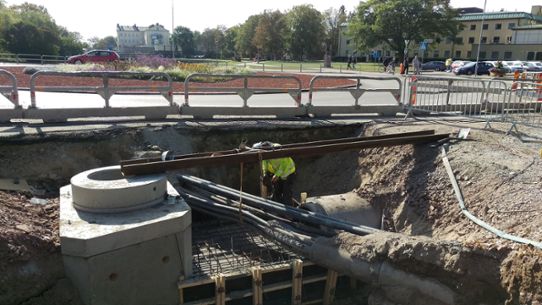Climate scenarios show that low groundwater levels and low levels in lakes and watercourses may become more common in the Kalmar region in future. Vital societal functions such as healthcare and the food industry are dependent on the availability of sufficient clean water. A serious shortage can lead to a crisis situation arising in society.
Neglected maintenance of the water and sewerage network
In Kalmar Municipality, maintenance of the water and sewerage network has been neglected for many years, the results of which include leaking pipes. A large proportion of the purified drinking water from the waterworks was therefore lost on the way to consumers. The average loss was around 20% of the total per year in the period 1997–2008.
Pipeline renewal
In 2008, Kalmar Vatten sharply increased the rate at which it renewed the pipeline network. The goal was to replace approximately 10 000 metres of pipeline each year. Assessments of the pipelines’ age, material and condition are used to determine the order in which renewal takes place under the redevelopment plan. This is so that the focus is on areas in which there is the greatest risk of supply disruptions. This renewal of the pipeline network means that less water is lost due to leakage and a larger proportion of the water reaches consumers.

Pipeline renewal is taking place across the entire water and sewerage network, with the drinking water pipelines, waste water drains and surface runoff drains being replaced. In order to cope with increased quantities of water in the future, Kalmar Vatten is also increasing the capacity of the pipeline network, primarily the surface runoff drains. At the same time, the company is working on quality improvements to extend the pipelines’ lifespan.
Financing
Kalmar Vatten increased the water and sewerage charges paid by its customers in order to implement the pipeline renewal. These charges have been gradually increased by a total of around 40% over the course of the period 2008–2013. The charge ended up at a level that is around the Swedish average.
More examples of climate adaptation
This is one of many examples of climate adaptation. There are more in the collection of ideas being built up by the Swedish National Knowledge Centre for Climate Change Adaptation at the Swedish Meteorological and Hydrological Institute (SMHI). The collection of examples has the aim of sharing experiences and providing ideas to everyone who works with climate adaptation. Examples describe concrete measures and challenges in several subject areas. They show how different actors have worked to adapt their activities to the climate changes that are already being noticed today and those that we cannot prevent in the future.